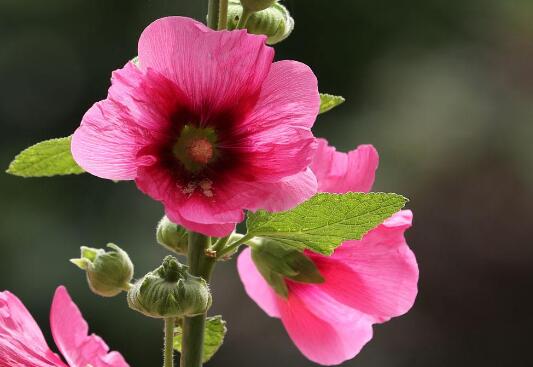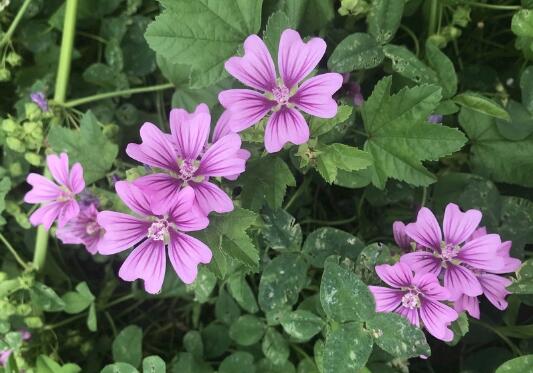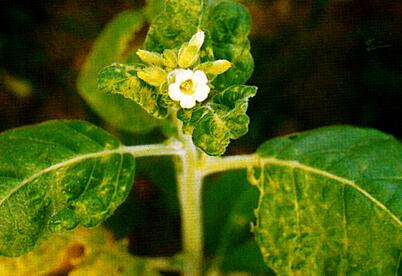What should we do if the hollyhock grows insects? disease and pest control of hollyhock / 2 insect pests 2 diseases
In the process of cultivating hollyhock, the last thing we want to encounter is the problem of diseases and insect pests, which do great harm to the plant, not only affect its ornamental, but also lead to its wilting phenomenon. So what if the hollyhock has worms? How to prevent and control the diseases and insect pests of hollyhock? Next, the editor will take you to learn about it.
What if the hollyhock has a worm? find the reason.

If we want to know what to do when the hollyhock grows, we first need to know what kind of insect is growing, so that we can deal with it pertinently, because the prevention and control methods of each kind of diseases and insect pests are different. We need to treat them with different drugs according to different diseases and insect pests. The details are below. Let's take a look.
II. Disease and pest control of hollyhock (pest)
1. Red spider
Among the diseases and insect pests of hollyhocks, red spiders have a relatively high incidence. This pest is red in shape and is a small plant. This pest mainly feeds on the leaves of hollyhocks, resulting in many potholes in the leaves. Very beautiful.
Control method: when dealing with the pest of red spider, we can use 2500-3000 times EC to spray it, it is best not to use pyrethroid pesticide, because it has no effect on mites.
two。 Borer
Borer is a kind of pest belonging to Lepidoptera. This pest generally has a high incidence in the south. It mainly harms the leaves of hollyhock. It will cause its leaves to gradually curl and wither, and finally fall off gradually.
Control method: when controlling the diseases and insect pests of this kind of hollyhock, we can directly use the Bt wettable powder with a content of 16000IU/ mg to spray and kill it.
3. Disease and pest control of hollyhock (disease)
1. Rust disease
Rust is a disease that occurs in many plants, and hollyhock is no exception. This disease mainly threatens the leaves, stems and fruits of plants. During the disease, many blister spots will appear in the affected parts, and when serious, the blister spots will be dense and the plants will die quickly as a result.
Control method: when controlling the diseases and insect pests of this kind of hollyhock, we can use 1000-1500 times of methyl topiramate wettable powder to spray the diseased plant, which is usually sprayed once every 7-10 days, and can be cured after 2-3 times.
two。 White spot disease
White spot is a common disease, which can appear in many plants. It mainly threatens the leaves of hollyhock. There are many small brown disease spots on the leaves when the disease occurs. With the passage of time, the center of the disease spot will be gray-white, the outer edge will be reddish brown, and a gray-brown mildew layer will be produced on the disease spot in the humid environment.
Control methods: in the prevention and control of this kind of hollyhock diseases and insect pests, we can use 75% chlorothalonil wettable particles 800 times liquid or to spray it, generally every 10 days once, 3-4 times can be cured.
What to do with the occurrence of diseases and insect pests of hollyhocks? prevention and control of diseases and insect pests of hollyhocks.
Hollyhock is a common ornamental flower in China. Hollyhock is native to Sichuan, China, so it is called "hollyhock". Later, because hollyhock can grow several feet tall, the flowers are mostly red, also known as "Yizhang Hong". Hollyhock blossoms when the wheat is ripe in June and is also affectionately known as "barley ripe". Hollyhock is easy to grow, but it is also prone to diseases and insect pests. What if diseases and insect pests occur in hollyhocks? This article introduces the prevention and control of diseases and insect pests of hollyhock in detail.
What to do with the occurrence of diseases and insect pests of hollyhocks? prevention and control of diseases and insect pests of hollyhocks.
The damage caused by red spiders during the growth of hollyhocks was caused by red spiders, and when it was serious, 1.8% avermectin EC was sprayed evenly with 7000 to 9000 times of EC, or 2500 to 3000 times of 15% abamectin EC had a better control effect. Do not use dichlorvos to kill mites. Dichlorvos can stimulate the proliferation of mites. Do not use pyrethroid pesticides, which are basically ineffective against mites.
Sometimes cotton leaf roller harms hollyhock leaves, which can be sprayed with 16000IU/ mg Bt wettable powder solution, or 25% diflubenzuron suspension 1500 to 2000 times, or 20% rice full suspension 1500 to 2000 times, and so on.
The perennial old hollyhock is prone to sunflower rust, the leaves of the susceptible plants turn yellow or die, and brown and powdery spores can be seen on the back of the leaves. Spraying Bordeaux solution on plants in spring or summer or disinfecting seeds before sowing can have a control effect. At the initial stage of the disease, 15% vermicellin wettable powder can be sprayed 1000 times, or 70% methyl topiramate wettable powder 1000 to 1500 times, or 75% chlorothalonil wettable powder 1500 times, etc., once every 7 to 10 days, 2 to 3 times in a row, all have good control effect.
White spot of hollyhock
White spot of hollyhock (hollyhock white spot), also known as spot blight, mainly harms the leaves of hollyhock. In the early stage of the onset of white spot disease of hollyhock, there were small brown spots on the leaf surface of hollyhock. With the development of the disease, the spot gradually expanded into round, oval or irregular shape, the center of the spot was grayish white and the outer edge was reddish brown. There is a grayish-brown mildew layer on the disease spot in a humid environment.
Prevention and control of white spot disease of hollyhock:
1. Remove the diseased leaves in time and pay attention to the density of branches and stems to keep the plants ventilated and transparent.
2. Increase the application of phosphorus and potassium fertilizer of hollyhock, little or no nitrogen fertilizer.
3. At the initial stage of the disease of hollyhock, 75% chlorothalonil wettable granule 800x liquid or 50% carbendazim wettable granule 500x liquid or 70% methyl thiophanate wettable granule 1200 times liquid spray can be used for prevention and control, once every 10 days, spraying 3 times successively for 4 times can effectively control the disease.
The above is a brief introduction to the occurrence of diseases and insect pests of hollyhock, and the prevention and control of diseases and insect pests of hollyhock. The most important point of disease and pest control of hollyhock is to understand its growth habits. Hollyhocks like an environment with plenty of light and good ventilation. Hollyhocks are not resistant to waterlogging, so it is necessary to avoid heavy rain. At the same time, hollyhock likes sandy soil that is loose and fertile, well drained and rich in organic matter.
Disease and pest control of hollyhock, pesticide to solve the problem
Hollyhock is cold-resistant, likes sunny environmental conditions, is resistant to semi-shade, afraid of waterlogging, and has strong resistance to salt and alkali. The root system of hollyhock is well developed and the leaves grow with each other. The disease and insect pest of hollyhock is also one of the main killers that threaten its growth.
The old hollyhock growing for many years is prone to sunflower rust, the leaves of susceptible plants will turn yellow until they die, and there will be brown, powdery spore piles on the back of the leaves. In spring and summer, spraying Bordeaux solution on the plant or disinfecting the seeds before sowing can prevent the diseases and insect pests of hollyhock. At the initial stage of the disease, 15% vermicellin wettable powder 1000 times or 70% methyl thiophanate wettable powder 1000 to 1500 times, or 75% chlorothalonil wettable powder 1000 times, spray once every 7 to 10 days, even 2 to 3 times, there will be a significant effect.
During the growth of hollyhock, there will be spider harm, affecting the growth of hollyhock, in serious cases, spray 1.8% avermectin EC 7000 to 9000 times uniform spray control, or use 15% acarine EC 2500 to 3000 times, has a good control effect. Do not use dichlorvos to kill mites. Dichlorvos can stimulate the proliferation of mites.
- Prev

What to do with the long insects of sunflower? pest control of sunflower / 2 insect pests 2 diseases
In the process of breeding sunflower, the last thing we want to encounter is the problem of diseases and insect pests, which do great harm to it. If we do not deal with it in time, it is easy to cause the plant to wilt. What about the sunflower worms? How to prevent and control diseases and insect pests of sunflower?
- Next

Oncidium disease control, Oncidium mosaic/soft rot/whitefly control measures
Oncidium because of its colorful and attractive, but if in the breeding time, Oncidium environment and methods are not right is difficult to see beautiful flowers, but also may cause Oncidium mosaic disease, soft rot, etc., so pay attention to prevention and treatment
Related
- Fuxing push coffee new agricultural production and marketing class: lack of small-scale processing plants
- Jujube rice field leisure farm deep ploughing Yilan for five years to create a space for organic food and play
- Nongyu Farm-A trial of organic papaya for brave women with advanced technology
- Four points for attention in the prevention and control of diseases and insect pests of edible fungi
- How to add nutrient solution to Edible Fungi
- Is there any good way to control edible fungus mites?
- Open Inoculation Technology of Edible Fungi
- Is there any clever way to use fertilizer for edible fungus in winter?
- What agents are used to kill the pathogens of edible fungi in the mushroom shed?
- Rapid drying of Edible Fungi

